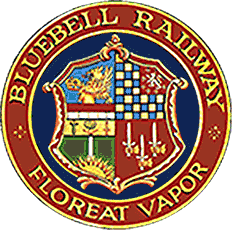Locomotives -
Operational Locos -
Locos under overhaul -
Locos on static display -
Locos formerly based on the Bluebell
Loco Roster -
Loco Stock List -
Loco Works News -
Join the Loco Dept


Great Western Railway "Dukedog" or "Earl" class
4-4-0 No. 9017 'Earl of Berkeley'
This locomotive is currently on loan to the Museum
at the Vale of Rheidol Railway in Aberystwyth

The Dukedog on the day it returned to service after overhaul, 1 November 2003 (Richard Salmon)
Nicknamed "Dukedogs" since they were an amalgamation of the chassis of a Bulldog with the boiler of a Duke, the parts of this loco are thus actually older than the "building" date suggests. A few of the class carried the names of Earls, but 3217 did not receive its allocated name until preservation days. At the time the Earls in question indicated to the GWR that, if their names were to be used, they would prefer their names on something a little more prestigious, and so they were transferred to new Castle class locomotives.
This class of locos was widely used on the Cambrian lines. John 'Abergynolwyn' Davies worked on Dukedog locomotives in Ceredigion during the 1950s. He remembers working on Dukedog No. 9017 in the summer of 1955, which became one of the 'best working weeks' of his whole life. He said: "I spent a glorious week in the summer of 1955, firing No. 9017 with driver Tom Phillips. We worked the 9.55 am 'all stations' from Aberystwyth to Welshpool each day, where we serviced the engine; our return working was the 'Cambrian Coast Express', all the way to Aberystwyth. Working with Tom felt like a 'holiday job', because of his light handling of the loco. It was one of the best working weeks of my life."
At the time this loco was saved for preservation the Bluebell was the only line where it could run, and it has been in Sussex ever since, apart from a few years spent at the Great Western Society, at Didcot, and more recently occasional visits to other lines.
No.9017, was the subject of the first-ever appeal for funds to purchase a standard gauge locomotive for preservation, with the intention of it being preserved on the Bluebell Railway (the only suitable home for it in 1961), the funds being collected by Mr Tom Gomm, on behalf of the Bluebell.
Oliver Veltom, Oswestry District Traffic Superintendent, who had already safeguarded the survival of Welshpool & Llanfair locomotives Nos. 822 and 823 from the scrap man by keeping them in Oswestry Works from 1956 to 1962, had placed 9017 in-store at Oswestry Works through 1961, to give time for the funds to be raised through the initial appeal. However, because there were still thousands of steam locomotives around, the appeal failed and Tom Gomm (of the enamel badge fame), with assistance from Peter Summers (who also covered the cost of transport to the Bluebell), stepped in to fund the difference between what was raised and the asking price, and then placed the locomotive on permanent loan to the Bluebell Railway. When it arrived it came with a good supply of the best Welsh steam coal!
The locomotive has now been donated to the Bluebell, with the requirement that the locomotive is to remain normally on the Bluebell Railway.

The nameplates (from Castle No. 5060) were carried from September 1963. It carried '9017' number plates until, following the withdrawal of 0-6-0 No. 3217, the locomotive was reunited with its original number plates in early 1965.
The tender attached to 9017 on arrival at Sheffield Park was No.1805 of July, 1911. This was fitted to one of the 4301-20 series of "Mogul" 2-6-0s when new, probably No. 4305. A replacement tender was acquired within a couple of years. This was No.2331 of September, 1921, which had first been fitted to locomotive No.6389. This tender was repainted for use with the Dukedog over Easter 1965. No.3217 ran temporarily with the C-class tender from 12 September 1971 until withdrawn for overhaul in December 1973. Its overhaul was not started until 1980, with a return to service two years later, with its tender now also restored.
Following its next overhaul, the locomotive returned to traffic on the 1st November 2003, when it was re-commissioned by Charles Hendry MP, a Bluebell Railway member. In the course of the overhaul, major boiler work was required, including the fitting of a new smokebox tube plate, manufactured in our own workshops, and complete new sections of front and back main frames. More details are to be found on the old Locomotive Department Photo News pages.

The engine was re-painted in BR black in April 2009 (during a visit to Llangollen, as seen in the photo on the left). Derek Hayward's photo below shows the locomotive the following year on the Bluebell. His photo above shows it in 2011, with the background to the nameplates and numberplates painted red. It came out of service in early June 2011 with a number of boiler and mechanical faults, and now awaits its next major overhaul.
In 2014 its tender, which is of an appropriate design, was hired to The Dinmore Manor Group, while their own tender was being made ready. It can be seen behind 'Dinmore Manor' on The Gloucestershire Warwickshire Railway in Dave Bowles photo, linked here.
Following several years stored under cover but out of public view, on 26 February 2024 No. 9017 left Sheffield Park for a 2-year loan to the Museum at the Vale of Rheidol Railway. This new museum, where the locomotive will be on public display, has been created in the old GWR Aberystwyth Locomotive Shed. This is a most appropriate location since the 'Dukedog' class was ubiquitous in the area, and 9017 was itself shedded in that very building in the 1950s.
This locomotive is considered a good candidate for an overhaul once workshop capacity is available at Sheffield Park, in view of the major work undertaken during its last overhaul, subsequent work on its valves and pistons, and consequent relatively good condition.
The second photo below shows the Cambrian Coast Express, at Tywyn in 1957 with No. 9017 piloting a 45xx tank loco. (© Ted Hamer)


 Class: Earl (later 90XX), but often known as "Dukedog"
Class: Earl (later 90XX), but often known as "Dukedog"
Wheels: 4-4-0, double frames
Class Introduced: 1936
Rebuilt: Swindon, 1938 using frames from "Bulldog" No. 3425 (built 1906)
and boiler and cab from "Duke" class No. 3282 (originally named 'Chepstow Castle' and built in 1899)*
Purpose: light passenger work
Total number rebuilt: 29
Numbers carried: GWR 3217, 9017 and BR 9017
Withdrawn: (Oswestry) October 1960
Length: 56ft 1.5in overall
Weight: Engine 49 Tons, Tender 40 Tons
Water capacity: 3,500 Gallons
Coal capacity: 6 Tons
Boiler Pressure: 180 lb/sq.in
Driving Wheels: 5ft 8in diameter
Cylinders: (2, inside) 18" x 26"
Tractive Effort: 18,955 lbs
Engine Brake: steam, via vacuum
BR power classification: 2P
Right: In June 1973, 3217 doubleheads a northbound train with a Brighton Terrier. The photo was taken on the 1 in 75 climb of Freshfield bank. Note the tender borrowed from the SECR C-class. Photo © Copyright Michael Taylor.
Arrived on Bluebell: 15 February 1962
Latest overhaul completed: 1 November 2003
Last operational: June 2011
Previous periods of service:
1962 to 1973
July 1982 to Autumn 1983
May 1986 to Autumn 1989
Current status: Awaiting overhaul, on loan to the Museum at the Vale of Rheidol Railway in Aberystwyth
Owner: Bluebell Railway
* It was officially a replacement of "Duke" No. 3258 'The Lizard'. However, the official records, supported by photographic evidence, show that little, if anything, of 'The Lizard' came into the rebuilt engine and that the boiler and cab came from No. 3282, built at Swindon in 1899, and originally named 'Chepstow Castle' but loosing its plates to a 4-6-0 in the 'twenties.
See a Photo of the loco during its visit to GWS, Didcot. The visit took place between August 1984 and June 1989 during which time repairs were made to the firebox, and the driving wheels fitted with replacement tyres.
Photos are also available of it with 'City of Truro' during the visit of the latter locomotive during 2006.


Return to BRPS Home Page,
to the Timetable or to Special
Events
Locos Intro -
Operational Locos -
Locos under overhaul -
Locos on static display -
Locos formerly based on the Bluebell
Loco Roster -
Loco Stock List -
Loco Works News -
Join the Loco Dept
Visitor Info. -
Museum -
Trust -
Catering -
Contacts -
What's New -
Projects -
Locos -
Carriages & Wagons -
Signals -
History -
Other -
Links -
Search -
FAQ
Why not become a BRPS Member? -
Get more involved as a Volunteer
Your ideal Film/TV location?
 Last updated by Richard Salmon, 14 December 2024
Last updated by Richard Salmon, 14 December 2024
© Copyright BRPS. Privacy Policy
|












 Class: Earl (later 90XX), but often known as "Dukedog"
Class: Earl (later 90XX), but often known as "Dukedog"
